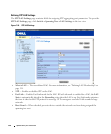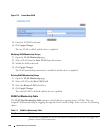
126 Update with your book title
–
Disable
— Device establishes shared, half duplex links.
–
Auto
— Device automatically determines the state.
•
Point-to-Point Operational Status
— Displays the point-to-point operating state which depends on a
link partner.
•
Activate Protocol Migration Test
— Select to run a Protocol Migration Test. The test identifies the
STP mode of the interface connected to the selected interface.
–
Checked
— Runs a Protocol Migration Test on the interface after you click the Apply button.
–
Unchecked
— Does not run a Protocol Migration Test.
Enabling RSTP
1
Open the
Rapid Spanning Tree (RSTP)
page.
2
Define the
Point-to-Point Admin
,
Point-to-Point Oper
, and the
Activate Protocol Migration
fields.
3
Click
Apply Changes
.
Rapid STP is enabled, and the device is updated.
Configuring VLANs
VLANs are logical subgroups of a Local Area Network (LAN) created via software rather than defining a
hardware solution. VLANs combine user stations and network devices into a single domain regardless of
the physical LAN segment to which they are attached. VLANs allow network traffic to flow more
efficiently within subgroups. VLANs managed through software reduces the amount of time in which
network changes are implemented.
VLANs have no minimum number of ports, and can be created per device or any other logical
connection combination, as VLANs are software based and not defined by physical attributes.
VLANs function at Layer 2. Since VLANs isolate traffic within the VLAN, a Layer 3 router functioning
router is needed to allows traffic flow between VLANs. Layer 3 routers identify segments and coordinate
with VLANs. VLANs are broadcast and Multicast domains. Broadcast and Multicast traffic is transmitted
only in the VLAN in which the traffic is generated.
VLAN tagging provides a method of transferring VLAN information between VLAN groups. VLAN
tagging attaches a tag to packet headers. The VLAN tag indicates to which VLAN the packet belongs.
VLAN tags are attached to the packet by either the end station or by the network device. VLAN tags also
contains VLAN network priority information. Combining VLANs and GVRP enables the automatic
dispersal of VLAN information. To open the VLAN page, click Switch
→ VLAN in the tree view.
Defining VLAN Members
The VLAN Membership page contains fields for defining port membership in the VLAN. The device
supports 64 VLANs. All ports must have a defined PVID. If no other value is configured the default
VLAN PVID is used. VLAN number 1 is the default VLAN, and cannot be deleted from the system. To
open the VLAN Membership page, click Switch
→ VLAN→ VLAN Membership in the tree view.


















